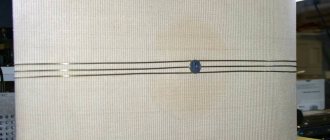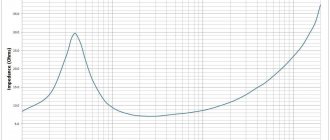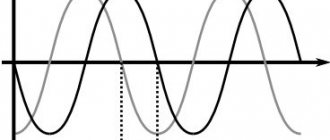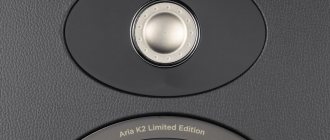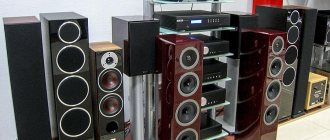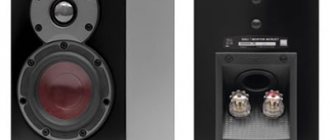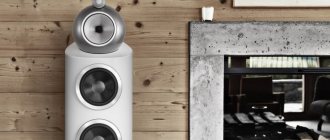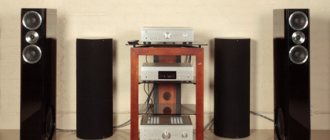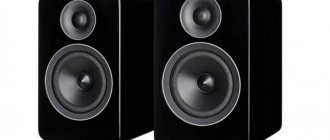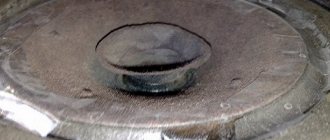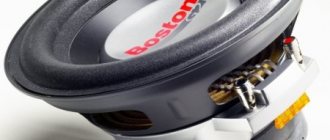Recently, acoustic systems with open acoustic design - shields or shallow open boxes - have gained recognition among some radio amateurs. Even industrial acoustics have been produced using this design, which have been highly praised by experts. The photo shows the famous Jamo R909 system
. Some of the problems with this solution are outlined in the article, my translation of which is given below.
↑ Preface
At the beginning of their evolution, acoustic systems (AS) were only of the open type.
Then, gradually, but almost completely, there was a transition to closed design. We will consider bass reflexes, bandpasses and other options as closed speakers, i.e. designs in which the front side of the diffuser directly radiates the speaker into the room, and the back into the closed volume of the box or into the room, but through resonators or other structures that impede the movement of air. Closed designs made it possible to sharply reduce the volume of speakers and radically expand the frequency range downwards. The industry has almost completely switched to producing speakers specifically for closed designs. Entire generations have grown up who have heard nothing but ZY. However, many people think that “they threw out the baby with the bathwater” because they believe that the sound of the middle frequencies, the main ones for the perception of frequencies, has deteriorated.
Therefore, among radio amateurs and some acoustics manufacturers, interest in open acoustic designs has again appeared (hereinafter, for simplicity, we will call them OY). The problem is that today they practically do not produce special speakers for OY because they are in low demand, small companies can produce them for amateurs, but due to the small circulation they will be expensive.
I would like to bring to your attention my free translation of the article by Martin J. King “Designing a Passive Two Way Open Baffle Speaker System”. I think the problems raised and their solutions will be interesting.
Open and closed headphones
Experts interpret openness this way - it is a slight isolation on both sides when listening to music tracks, the melody is audible to others, and the user catches all extraneous sounds. Such headphones do not have effective protection from external sounds, and the outer part of their design is made in the form of perforations or mesh, through which external sounds freely penetrate inside, and the music is heard by others.
Open headphones are most suitable for listening to works with an abundance of high and mid frequencies, i.e. for lovers of the classics. Devices with a closed design are products with good sound insulation that do not allow sound to pass through either from the outside or from the inside.
Therefore, closed-type headphones have the following features:
- They are equipped with dense ear pads to ensure a complete fit to the ears.
- In full-size analogues, the ear pads completely cover the auricle, creating a certain acoustic space inside for a more comfortable perception of sound effects.
- The outer part of the devices does not have cracks or perforations, so sound does not penetrate outside and is not heard by strangers.
These devices are attractive to fans of rock or metal because the bass is heard most noticeably and clearly.
What's the difference between them
The difference between closed and open headphones can be represented using the following key points:
- The open ones do not have components that can provide complete isolation from external noise, while the closed version, on the contrary, is equipped with reliable insulation from the penetration of sounds in any direction. The first option is ideal for lovers of classical music, while the second is ideal for metalheads and rock fans.
- Open products are good for use at home, as well as in places where listening to your favorite tracks will not disturb others. Closed devices, on the contrary, are suitable for public places and offices.
Only high-tech headphones can provide high-quality and complete isolation; budget models provide normal listening only in enclosed spaces with low and medium noise levels.
Combined models are available - half-open or half-closed, so you can find any option for yourself.
Characteristics
All main parameters are indicated in the product passport; we will not list them; they will be described specifically for each model in a special section below. It is only worth noting that some products come with noise insulation made in various ways - these could be, for example, thick ear pads made of genuine leather that tightly cover the ear, not letting in external noise and preventing sounds from leaking out.
The design may be different, but the essence is the same - reliable protection from extraneous noise. In addition, some models are available with noise reduction for distortion and other sounds that appear during playback of the installed equipment.
↑ Homemade products on the Internet
An Internet search for homemade OJ designs yields a wide variety of sizes, shapes, numbers, and types of speakers, whether passive or active filters are used.
Some use trial and error in practice, others engage in computer modeling to predict the frequency response based on sound pressure. Both methods work and can create ready-made speaker designs. For experimenting DIYers, it is very attractive that AC OY models can be easily, cheaply and simply made from plywood or cardboard, listened to and made acoustic measurements, and changes to the design can be made by cutting off pieces or extending them with pieces of plywood or cardboard.
AU OYA forgives big mistakes in design, but the weak point is the bass. You can correct the lack of bass using an additional subwoofer. In this case, the results of bass reproduction will be quite predictable, especially if you measure the TS parameters of a specific head and use computer programs to manufacture the subwoofer enclosure. AC speakers have the property of a smooth decline in low frequencies; the frequency of the beginning of the decline is usually determined by the size of the front panel and is quite predictable.
A compromise between a completely experimental method and computer modeling is programs such as EDGE. The EDGE program helps determine the influence of front panel dimensions on the formation of frequency response at low frequencies. But this is only one piece of the puzzle. Typically, other parts of the puzzle are neglected and the focus is solely on calculations. In my opinion, sometimes too much attention is paid to the curves that programs produce and they forget about the factors that the program does not take into account.
I really like full-range speakers and the lack of filters in the midrange, so I'm going to give them as much bandwidth as possible, adding the very edges of the range to the tweeter and bass section. Unfortunately, there are no speakers capable of reproducing the full range of frequencies, and even in an open design (or they are unavailable). At the same time, one good speaker can fully reproduce the entire midrange range with high quality.
In this project, the lowest frequencies will be provided by the woofer; the crossover frequency will be 100...200 Hz for the wideband head.
“Anatomy” of home acoustic systems: materials and acoustic design
This is a new series of posts dedicated to acoustic systems. Due to the fact that the topic is extremely broad, we decided to create a series of articles reflecting the selection criteria when purchasing speakers. This post is dedicated to the acoustic properties of cabinet materials and acoustic design. The post will be especially useful for those who are faced with choosing speakers, and will also provide information for people who want to create their own speakers in the process of their DIY experiments.
There is an opinion that one of the decisive factors affecting the sound of speakers is the material of the housing. PULT experts believe that the importance of this factor is often exaggerated, however, it is truly important and cannot be written off. An equally important factor (among many others) that determines the sound of speakers is the acoustic design.
I warn you, the material contains links to products not as explicit jeans, but as examples (I hope it won’t offend anyone), everything is strictly within the scope of the topic.
Tree - from felling to golden ears
Due to its good absorption properties, wood is considered one of the best materials for making speakers.
(the sound absorption coefficient of wood, depending on the species, ranges from 0.15 – 0.17 at 125 Hz to 0.09 at 4 kHz)
Solid wood and veneer are used relatively rarely for the production of speakers and, as a rule, are in demand in the HI-End segment. Wooden speakers are gradually disappearing from the market due to low manufacturability, instability of the material and prohibitively high cost.
It is interesting that in order to create truly high-quality speakers of this type that meet the requirements of the most sophisticated listeners, technologists must select material at the cutting stage, as in the production of acoustic musical instruments. The latter is related to the properties of wood, where everything is important, from the area where the tree grew, to the humidity level of the room where it was stored, the temperature and duration of drying et setera. The latter circumstance makes DIY development difficult; in the absence of special knowledge, an amateur creating a wooden speaker is doomed to act by trial and error.
Manufacturers of such acoustics do not report how the situation really is and whether the described conditions are met, and accordingly, any wooden system requires careful listening before purchasing. With a high degree of probability, two speakers of the same model from the same breed will sound slightly different, which is especially important for some discerning listeners with golden ears with big money.
Columns from an array of valuable rocks are available in units, their cost is astronomical. Everything yours truly has heard sounds excellent. However, in my subjectively pragmatic opinion, it is disproportionate to the cost. Sometimes, well-designed enclosures made of plywood and MDF have no less musicality, but for many audiophiles “not wood” = “not true hi-end”, and for some, “not wood” simply does not allow the status or spoils the interior design.
I believe that one of the best wooden systems in our catalog is this: Floor-standing acoustics (price appropriate)
Plywood is almost a tree if it hasn't flown over Beijing
Plywood, used for the production of acoustic enclosures, has from 10 to 14 layers and is almost as good as wood in terms of acoustic properties, in particular in sound absorption, while being somewhat cheaper than wood, more technologically advanced in processing, lighter than chipboard and MDF. Multilayer plywood dampens unwanted vibrations well due to the structure of the material.
(sound absorption coefficient of 12-layer plywood ranges from 0.1–0.2 at 125 Hz to 0.07 at 4 kHz)
Like wood, plywood is used in quite expensive and sometimes luxury piece products. The cost of plywood speakers is not much lower than those made from solid wood, and are quite comparable in quality.
In some cases, the declared cases are made of chipboard and MDF. Therefore, low prices for speakers with plywood or wooden casings should alert you. A number of small Asian manufacturers, which change names regularly and sell mostly online, create composite cabinets that include a few small but noticeable plywood (wood) elements, with the bulk made from chipboard.
Among the speakers made from plywood, I can especially highlight this one (the cost is quite affordable for plywood shelf options):
Chipboard – thickness, density, humidity
Chipboard is comparable in cost to plastic, but does not have a number of disadvantages that are inherent in plastic cases. The most significant problem of chipboard is low strength, with a fairly high mass of material.
Sound absorption in chipboard is non-uniform and in some cases low- and mid-frequency resonances may occur, although the likelihood of their occurrence is lower than with plastic. Plates with a thickness of more than 16 mm, which achieve the required density, can effectively dampen resonances. It should be noted that, as in the case of plastic, the properties of a particular chipboard are of great importance. It is important to take into account the density and humidity of the material, since different chipboards differ in these parameters. Thick, dense chipboards are often used to create studio monitors, which indicates the demand for the material in the production of professional equipment.
On a note, for fellow DIY fraternity, chipboard with a density of at least 650 - 820 kg/m³ (with a board thickness of 16 - 18 mm) and a humidity of no more than 6-7% is well suited for creating speakers. Failure to comply with these conditions will significantly affect the sound quality and reliability of the speakers.
Among the worthy chipboard options for home speakers, our experts highlight:
MDF: from furniture to acoustics
Today, MDF (Medium Density Fiberboard) is used everywhere, among other things, MDF is one of the most common modern materials for the production of acoustics.
The reason for the popularity of MDF was the physical properties of the material, namely:
- Density 700 - 800 kg/m³
- Sound absorption coefficient 0.15 at 125 Hz – 0.09 at 4 kHz
- Humidity 1-3%
- Mechanical strength and wear resistance
The material is cheap to produce, has acoustic properties comparable to those of wood, while the resistance of the boards to mechanical damage is somewhat higher. MDF has sufficient acoustic rigidity of the speaker cabinet, and sound absorption meets the parameters necessary for creating HI-FI acoustics.
Visual difference between MDF and chipboard
There are a lot of wonderful systems among MDF acoustics; in my opinion, the optimal ones in terms of price/quality ratio are the following: - shelf - floor-standing
Aluminum alloys - design and precise calculations
The most common metal in the production of speakers is aluminum, as well as alloys based on it. Some authors and experts believe that the aluminum housing reduces resonances and also improves the transmission of high frequencies. The sound absorption coefficient of aluminum alloys is not high, and is about 0.05, which, however, is significantly better than that of steel. To reduce body vibration, increase sound absorption and prevent harmful resonances, manufacturers use sandwich panels, where a layer of high molecular weight polyethylene resins or other low-density materials, such as viscoelastic, is placed between 2 aluminum sheets.
In the case of budget aluminum speakers, manufacturers often rely on design at the expense of sound: as a result, the acoustic characteristics leave much to be desired. Sometimes users of such acoustics complain of a harsh, distorted sound caused by insufficient sound absorption of the housing. Due to the fact that waves are well reflected and poorly absorbed, precise calculation of the housing design, selection of emitters, filters used, as well as the quality of connections of individual parts become very important in metal acoustics.
Among decent-sounding aluminum speakers, I was especially impressed by the sound: (the price is impressive, but not prohibitive)
Stone – granite slabs at the price of gold bars
Stone is one of the most expensive materials for the production of acoustic enclosures. Impeccable reflection and the practical impossibility of the appearance of vibrational resonances make these materials in demand among particularly demanding listeners.
Most rocks have a stable sound absorption coefficient, which, for example, for granite is 0.130 for the entire spectrum of sound frequencies, and for limestone 0.264. Manufacturers especially value porous stones, which have higher sound absorption. Using stone slabs to make DIY acoustics is almost impossible, since it requires not only remarkable knowledge in acoustics and stone processing, but also extremely expensive equipment (no one produces home-made 3-D stone milling machines yet).
For the production of serial speakers, rocks such as granite, marble, slate, limestone, and basalt are used. These rocks have similar acoustic properties, and with appropriate processing they become real works of art. Stone enclosures are often used to create landscape acoustics; in such cases, a cavity is created in the raw stone to accommodate the emitter, in which fastening elements are installed (usually made to order).
The stone has 2 main problems: cost and weight. The price of a stone speaker may be higher than any other with similar characteristics. The weight of some samples of floor systems can reach 40 kg or more.
Glass transparency and sound quality
An original solution is to create speakers from glass. So far, only two companies, Waterfall and SONY, have seriously succeeded in this matter. The material is interesting from a design point of view; acoustically glass creates certain problems, mainly in the form of resonances, which the above-mentioned companies have learned to solve; there are even reference options.
The prices for the transparent miracle can also hardly be called affordable; the latter is associated with low manufacturability and high production costs.
Of the glass samples that impressed with their sound, I can recommend:
Acoustic design - boxes, tubes and horns
Acoustic design is no less important for accurate sound transmission in speakers. I will talk about the most common types (it is natural that certain types can be combined depending on the specific model, for example, the bass-reflex part of the speaker is responsible for the low and mid-frequency range, and a horn is built for high frequencies).
Bass reflex - the main thing is the length of the pipe
A bass reflex is one of the most common types of acoustic design. This method allows, with the correct calculation of the length of the pipe, the cross-section of the hole and the volume of the housing, to obtain high efficiency, an optimal frequency ratio, and amplify low frequencies. The essence of the phase inverter principle is that on the back of the body there is a hole with a pipe, which allows you to create low-frequency oscillations in phase with the waves created by the front side of the diffuser. Most often, the bass reflex type is used when creating 2.0 and 4.0 systems.
To facilitate calculations when creating your own speaker, it is convenient to use special calculators; I provide one of the convenient ones at the link
In the HI-END philosophy, there are extremely radical, uncompromising judgments about bass reflex systems; I present one of them without comment:
“Enemy No. 1 is, of course, nonlinear amplification elements in the sound path (then everyone, to the best of their education, understands which elements are more linear and which are less). Enemy No. 2 is the bass reflex. the bass reflex is designed to show off, it should allow a small cheap speaker to record 50... 40... 30 in the passport, and what a trifle even 20 Hz at a level of -3 dB! But the lower frequency range of the bass reflex ceases to be relevant to music; more precisely, the bass reflex itself is a pipe singing its own melody.”
A closed box is a coffin for extra low ones
The classic option for many manufacturers is a regular closed box with speaker diffusers brought to the surface. This type of acoustics is quite simple to calculate, but the efficiency of such devices is not great. Also, the boxes are not recommended for lovers of characteristically pronounced lows, since in a closed system without additional elements that can enhance the lows (bass reflex, resonator), the frequency spectrum from 20 to 350 Hz is poorly expressed.
Many music lovers prefer the closed type, since it is characterized by a relatively flat frequency response and realistic “honest” transmission of the reproduced musical material. Most studio monitors are created in this acoustic design.
Band-Pass (closed resonator box) – the main thing is not to buzz
Band-Pass became widespread in the creation of subwoofers. In this type of acoustic design, the emitter is hidden inside the housing, while the insides of the box are connected to the external environment by bass reflex pipes. The task of the emitter is to excite low-frequency oscillations, the amplitude of which increases many times thanks to the bass reflex pipes.
With a correctly calculated design of this type, there should be no such parasitic echoes as low hum, hum, etc., which is often the case with budget systems of this type.
Open body - no extra walls
A relatively rare type of acoustic design today, in which the rear wall of the housing is repeatedly perforated or completely absent. This type of design is used to reduce the number of housing elements that affect the frequency response of the speakers.
In an open box, the front wall has the most significant influence on the sound, which reduces the likelihood of distortion introduced by other parts of the case. The contribution of the side walls (if any are present in the structure), given their small width, is minimal and amounts to no more than 1-2 dB.
Horn design - problematic champions in sensitivity
Horn acoustic design is more often used in combination with other types (in particular for the design of high-frequency emitters), however, there are also original 100% horn designs.
The main advantage of horn speakers is their high sensitivity.
Most experts, not without reason, are skeptical about horn acoustics, for several reasons:
- Structural and technological complexity, and accordingly, high assembly requirements
- It is almost impossible to create a horn speaker with a uniform frequency response (with the exception of devices costing 10 kilobucks and above)
- Due to the fact that the horn is not a resonating system, it is impossible to correct the frequency response (a minus for DIYers who intend to copy a Hi-end horn)
- Due to the peculiarities of the waveform of horn acoustics, the sound volume is quite low
- Overwhelmingly relatively low dynamic range
- It produces a large number of characteristic overtones (considered a virtue by some audiophiles).
Horn systems have become the most popular among audiophiles in search of “divine” sound. The tendentious approach allowed the archaic horn design to get a second life, and modern manufacturers were able to find original solutions (effective, but extremely expensive) to common horn problems.
That's all for now. To be continued, as usual, but the “autopsy” will definitely show... I’ll announce for the future: emitters, power/sensitivity/room volume.
↑ Selecting speakers
When designing multi-band speakers with passive filters, special attention should be paid to the smoothest frequency response in terms of sound pressure.
The choice of bass driver depends on the size and shape of the front panel, the sound pressure level must be consistent with the mid-frequency response. The main link is the broadband head, which reproduces the most important range - mid frequencies, the remaining links are adjusted to it. To begin designing, you must first determine the desired end result. For loudspeakers, the bass roll-off will be 18 dB/octave. It consists of 12 dB/octave for the speaker and 6 dB/octave for the open design.
In Fig. Figure 1 shows the frequency response of a head with an output of 90 dB/W/m, the lower reproduced frequency of which is 45 Hz at a level of -3 dB. The broadband head (BH) in the OJ must provide the same 90 dB/W/m along its axis. The earpiece will be located approximately at the level of the ears of the seated listener. The task is to develop a housing that provides a smooth transition of the frequency response from the low frequency to the full frequency head. Silk output should be in the 88…92 dB range, many 3″, 4″ and 5″ heads are excellent candidates for this design. In table 1 shows some suitable heads from Fostex.
Having considered the speakers listed in table. 1, and taking into account that there will be a separate bass link to eliminate the need to reproduce the SB heads with the lowest frequencies, we conclude that the TS (Thiele/Small) parameters of the SB heads are of little interest to us. There are three dynamics from the table. 1, which have an output of 90 dB/W/m. Since cost was also a factor, I chose the FE103E for this project.
After selecting the SB and determining the sound pressure, the requirements for the bass section can be considered. If the woofer were installed in an infinity shield, an efficiency of 90 dB/W/m would be sufficient. But since the bezel size is finite and small, supporting bass frequencies results in a requirement that the subwoofer output be greater than 90 dB/W/m. For loudspeakers with passive filters, this requirement can be satisfied by using several woofers or one professional large diameter. I chose the second option, a larger diameter would provide the required efficiency, reduce cost, and ultimately, I believe, simplify the design.
For this study, I focused on three Eminence speakers that are often used in homemade PA systems. All of them have significantly greater sensitivity than 90 dB/W/m. Their Thiele/Small parameters from the manufacturer are shown in Table 2.
The main difference between them is the magnet used. Its dimensions directly affect the overall quality factor Qts and the price of the head. The minimum magnet, price and maximum total quality factor are Eminence Alpha 15A.
All three Eminence LF speakers were simulated in combination with a Fostex FE103E and a passive crossover filter. After repeated simulations of each design, the combination of Fostex FE103E and Eminence Alpha 15A turned out to be the best. During the research, I came to an understanding of why this happened this way. In Fig. Figure 2 shows the final front panel layout for the Fostex FE103E and Eminence Alpha 15A pair. The result was a panel measuring 20" wide and 38" high. The center of the bass is 10“ from the floor. It is better to make the right and left speakers mirrored.
In Fig. Figure 3 shows the calculated frequency response of the system at a distance of 1 m along the axis. The red curve is the result of calculations, the black one is the objective function. For the calculations, ideal filters of the 2nd order were taken; the result with real filters will be shown later. Another interesting feature of Fig. 3 is the output of 92 dB/W/m of the Fostex FE103E speaker. The simulation results show that the agreement with the required result is very good.
Screen calculation example
Let it be necessary to calculate the screen dimensions for a 0.5GD-37 with the following parameters: f0=315 Hz; b=0.08 m; Q = 2.3; m0=1.2•10-3 Kg if the permissible drop in the frequency response at frp.n is 6 dB . (The value m0 will be used in the next example.)
1. From (27) we find: frp.n = 1.4•343/3.14•0.08=1920 Hz ;
2. According to Fig. 32 we define: frp.n = 315 Hz ;
3. φ(Q)≈Q=2.3;
4. Screen area according to (28): S=0.15•3432/3152•2.32=0.034 m2;
5. With an acceptable drop in frequency response at the lower limit frequency equal to 6 dB , from () we find: S'=0.017 m2;
6. Select screen dimensions equal to (0.17×0.1) m2.
↑ How to get bass
To understand what and how the resulting bass of a speaker in an acoustic design is made up of, you need to find the components that influence it, separate them and examine each one. This will help in achieving results.
In Fig. Figure 4 shows the frequency response of the Eminence Alpha 15A in an infinity screen (dotted blue), in an infinity screen with floor reflection (solid red) and ideal (solid black), which is what we are aiming for. Compared to the ideal, calculated for an infinite screen with reflection from the floor, it has a rise of up to +10 dB at the lowest frequencies. Another interesting feature of the two calculated curves is the slight waviness that begins above 100 Hz, this is due to the directivity of the radiation of the 15" diameter head and reflections from the floor, we remind you that measurements are taken at height and at the listening position. When you change the listening point (measurement), or change the speaker height from the floor, the frequency response will change. We must not forget that the parameters of factory speakers are usually given in an anechoic chamber, where there is “no floor”.
In Fig. Figure 5 shows the effect of ideal 2nd order low pass filters (LPF). The calculated frequency response is shown: heads in an infinite screen with floor reflection from Fig. 4 (dashed red), 200 Hz LPF (dashed blue), result (solid red), and target (solid black).
The graphs shown in Fig.
6 have a number of interesting features. Let's start with the red dotted line, this is the frequency response in an infinite screen, as in Fig. 5 with a second-order low-pass filter at 200 Hz. The dotted blue line takes into account the dimensions of the real front panel and the location of the speaker on it, similar to the EDGE program. The combination of these two curves taking into account the phase, which is not shown, is depicted by the solid red line. Final conclusion: the frequency response of the low-frequency section meets the specified requirements with good accuracy. In Fig. 6, note the intersection of the two dashed lines at 165 Hz. Below 165 Hz, it is the limited width of the front panel that prevents the hump and allows the required frequency response to be achieved. This influence allows the effective crossover frequency to be increased to approximately 400 Hz. Based on the result shown by the solid red line, the high-pass filter frequency for the low-pass filter can be set (selected) higher than the 200 Hz frequency used for the low-pass filter. We looked at a design optimized for the Eminence Alpha 15A woofer. But in the table 2 there are two more similar speakers with a lower Qts value.
I have often heard reproaches regarding the relatively high Qts values of low-frequency speakers in OI design - on the bass, the transient characteristics will supposedly “ring” and hum on one bass note.
In Fig. Figure 8 shows the impulse responses of all three Eminences in the OJ. It can be seen that there is no big difference in the shape of the three pulses. The only noticeable difference is the increase in transient response time with increasing Qts, but since the Alpha 15A frequency range extends lower, it should have a slightly longer transient response. There is no evidence of excessive bass ringing from any of these three speakers. I emphasize once again that for OJ, better reproduction of low frequencies is achieved with a higher Qts Alpha15A.The best headphone models
Open type
Koss Porta Pro
pros
- light weight;
- originality of design;
- sound quality;
- adjustable speaker angle;
- folding design;
- storage bag.
Minuses
- headband pulls hair;
- poor sound insulation.
From 2000 ₽
Pressure regulator ear pads, foldable for transportation, 1.2 m wire, 3.5 mm mini Jack plug.
AKG K 612 Pro
pros
- clear sound with detail;
- wide stereo panorama;
- quite light;
- there is a mechanism for automatic adjustment to the size of the head;
- quality materials.
Minuses
- no spare cable.
From 12358 ₽
Beyerdynamic DT 990 PRO
pros
- high sound quality;
- excellent assembly;
- quality of materials;
- stylish design;
- Ease of use.
Minuses
- demands on the sound source.
From 11580 ₽
High quality full-size open headphones from a German company at an average price of 11.58 thousand rubles.
Shure SRH1840
pros
- best cost-quality ratio;
- excellent sound throughout the entire range;
- good equipment;
- hard carrying case.
Minuses
- short cord.
From 43490 ₽
Dynamic version, open type, includes a replaceable cord and two pairs of ear pads. Made in China.
Sony MDR-ZX660AP
pros
- sound quality;
- high quality materials;
- speakers rotate 90 degrees;
- convenient cord, quite durable;
- the overall design is very reliable;
- The headband is comfortable.
Minuses
- not found
From 3075 ₽
Open type, mini Jack 3.5 mm, made in Japan.
Closed type
Audio-Technica ATH-M40x
pros
- unique design;
- clear harmony of sound transmission;
- balanced model;
- reliability is beyond doubt;
- soft and pleasant to the touch ear pads;
- require careful handling.
Minuses
- only minor and purely subjective comments that do not affect the overall impression.
From 7134 ₽
Full-size, closed type, the kit includes two spare ones: twisted and straight. Made in Japan.
Shure SRH440
pros
- convincing build quality;
- structural strength (dropped several times, but still working);
- excellent sound on all ranges;
- The cable is twisted and removable.
Minuses
- My head sweats after using it for a long time.
From 6990 ₽
Full-size closed version, includes a 6.3 mm adapter, 3 m cable, made in China.
Axelvox HD272
pros
- excellent build quality to cost ratio;
- wide frequency range;
- The sound quality is impressive;
- high reliability of the design.
Minuses
- leatherette ear pads.
From 2820 ₽
Sennheiser HD 180
pros
- completely dampen all extraneous sounds from outside;
- fits perfectly, does not put pressure on the head;
- original design;
- robust construction;
- high quality plastic.
Minuses
- thin ear pad material.
From 1349 ₽
The 3 m cable connection is two-way, an adapter from a 3.5 mini jack to a 6.3 mm jack is included. German quality performed by Chinese specialists.
AKG K 52
pros
- high-quality assembly;
- excellent sound;
- comfortable headband;
- the ear pads do not put pressure on the ears;
- optimal cable length.
Minuses
- not found.
From 3235 ₽
Semi-open type
Beyerdynamic DT 880 Pro
pros
- comfort when listening to music throughout the day;
- excellent detail, wonderful bass;
- thoughtful design;
- quality of materials and workmanship.
Minuses
- not found.
From 20790 ₽
A full-size version of headphones from Germany at an average price of 20,790 ₽, during long-term use there were no major complaints.
AKG K 240 MK II
pros
- ease of construction;
- replaceable ear pads, connector and cable;
- fairly high quality sound;
- Ease of use.
Minuses
- not found.
From 8211 ₽
The average price today is 8,211 rubles, full-size semi-open version, spare ear pads included - two pairs and two cords: straight 3 m, twisted 5 m. Austrian design, made in China.
Samsung EO-HS1303
pros
- normal sound quality for a budget option;
- high build quality;
- optimal cable length.
Minuses
- not found
From 699 ₽
Earbuds with a microphone from specialists from South Korea at an average price of 699 ₽. Many users write negative reviews, but you have to look at the price, and the Koreans are great: they released a budget phone for mobile devices.
AKG K 121 Studio
pros
- quality of materials;
- comfortable headband;
- the ear pads do not rub your ears;
- excellent parameters allow you to connect to any sound source;
- used in professional work.
Minuses
- not found.
From 6552 ₽
Semi-open headphones with an average price of 6,552 rubles; the package includes a 6.3 mm adapter. Made in China under license from an Austrian company. Over many years of use, no significant disadvantages have been identified.
AKG K 141 MKII
pros
- balanced and detailed sound;
- excellent equipment;
- spare ear pads and cord;
- quality materials;
- comfortable headband.
Minuses
- not found.
From 9870 ₽
The overhead model is a semi-open type with an average price of RUB 9,870, gold-plated 3.5 mm connectors, a 6.3 mm adapter is available. Made in Austria. Over 5 years of active use, no negativity, only positive emotions and feelings.
↑ Operation over the entire frequency range
Let's consider operation over the entire frequency range. Outside the bass section, it is determined by the ShP head. The high-pass filter is used to filter out low frequencies and the associated large vibrations of the squelch diffuser. To understand the influence of different conditions on the frequency response, let's consider different acoustic design options.
In Fig. Figure 9 shows the calculated frequency response of the WB in an infinite screen (blue dotted line), in an infinite screen with reflection from the floor (solid red line), and the target frequency response (black line). The ripples in the solid red line are the result of reflections from the floor.
Rice. 10 adds the influence of an ideal 2nd order high-pass filter. Shown: calculated frequency response in an infinite screen with reflection from the floor from Fig. 9 (dashed red line), 500 Hz high-pass filter (blue dotted line), combined frequency response (solid red line), and target frequency response (black line).
Rice.
11 adds the influence of the final dimensions and shape of the bezel. When summing the frequency response Fig. 10 (red dotted line), front panel response graphic (blue dotted line), we get the result (solid red line). Pay attention again to Fig. 11 - the hump from the influence of the front panel (blue dotted line) is used to expand the full spectrum of the head downwards in frequency. As a result, the hump reduces the effective filter frequency to around 400 Hz. By setting the actual crossover frequency above the hump from the front panel, you can adjust the total frequency response closer to the required one.
↑ Passive filter diagram
As was written above, the optimal ones for simulation turned out to be a 2nd order low-pass filter with a knee frequency of 200 Hz and a 2nd order high-pass filter with a frequency of 500 Hz. Due to faceplate influence, second order filters actually operate at approximately 400 Hz. Filters and a list of components for it are given below in the table. 3 and diagrams in Fig. 12.
Substituting the actual ratings of the filter components into the simulator, taking into account the DC resistance of the inductors, we obtain the final result shown in Fig. 13.
Actual output is increased to 91 dB, the blue dotted lines indicate a deviation of +/- 2 dB from this level. The red line shows the final result of the project. The approximate cost of the project components is shown in table. 4.
↑ Conclusions
The biggest challenge for loudspeaker speakers with passive filters is achieving adequate bass in a reasonable faceplate size.
To solve this problem, it is necessary to take into account that the dynamic heads, housing and filters represent a single system that must be optimized to achieve the goal. I believe that a low crossover frequency will help optimize the system and avoid potential problems in the midrange region, which is very important for auditory perception. Since optimization is a complex problem that depends on a number of factors, simply replacing woofers in a speaker system cannot make definitive conclusions about the suitability of a particular speaker for the speaker system. The sound emitter, housing, and filter must be selected so that their combination provides the smoothest frequency response. I believe that the main reason for weak bass in open speaker systems with passive filters is the low overall quality factor of the Qts speaker and/or poor selection of the speaker set. The woofer must have a significantly higher output than the total output of the entire speaker, significantly higher than the midrange driver, to compensate for the low frequency roll-off.
The low quality factor of Qts exacerbates this problem. When Qts is low, a significant increase in the width of the front panel and/or a change in filter settings is required. A high-quality Qts speaker will have a flat low-frequency response and will be compatible with a reasonably wide bezel. My recommendation is to use woofers whose output is at least 6...10 dB higher than the rest of the speaker system and should have a Qts of approximately 1.0...1.2.
Analysis of the Lowther open speaker system confirms the conclusions made above. Lowthers sound great, but they're huge. The front panel with wings is 40" wide and 60" high. This design will require two Eminence Alpha 15A woofers and an active filter. Large speaker box sizes, multiple woofers and amplifiers will allow a sensitivity of approximately 98 dB/W/m to be achieved in the Lowther PM2A system. Impressed by their sound, I decided to build the same speaker in a huge cabinet with several woofers, an active filter and several amplifiers. During the construction process, I gained some experience and came to the conclusion that building a system from a “brute force” perspective is not the best solution.
↑ My comment on the article
Of course, the opinion of the author of the article is not an immutable truth and does not claim to be a final and complete solution to the problem, however, it is of interest to amateurs interested in acoustics.
I do not guarantee the complete accuracy of the translation, but I hope that I have presented the main provisions correctly. The lack of measurements using a microphone and specifically at home causes skepticism. It would be interesting to know the impressions of independent listeners-experts who have not “processed” the constructions by the author. But these are just my dreams.
